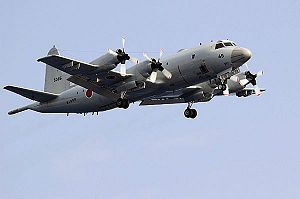P-3 Orion: Difference between revisions
Pat Palmer (talk | contribs) mNo edit summary |
mNo edit summary |
||
| (One intermediate revision by one other user not shown) | |||
| Line 43: | Line 43: | ||
*[[APS-135|AN/APS-137B(V)5]] [[radar]] with navigation, weather, and [[radar#synthetic aperture radar|SAR]] and [[radar#inverse synthetic aperture radar|ISAR imaging]]. is capable of multimode operation to provide periscope and small target detection, navigation, weather avoidance, long range surface search and Synthetic Aperture Radar (SAR) and ISAR imaging modes. SAR is best against fixed targets and ISAR against moving targets including surfaced submarines. All output can be recorded. | *[[APS-135|AN/APS-137B(V)5]] [[radar]] with navigation, weather, and [[radar#synthetic aperture radar|SAR]] and [[radar#inverse synthetic aperture radar|ISAR imaging]]. is capable of multimode operation to provide periscope and small target detection, navigation, weather avoidance, long range surface search and Synthetic Aperture Radar (SAR) and ISAR imaging modes. SAR is best against fixed targets and ISAR against moving targets including surfaced submarines. All output can be recorded. | ||
====Electronic warfare and electronic intelligence==== | ====Electronic warfare and electronic intelligence==== | ||
*[[EP-2060| EP-2060 Pulse Analyzer]] with [[ALR-66| AN/ALR-66C(V)3]] [[ELINT]]/[[electronic warfare|electronic support]] receiver. The C version incorporates a spinning | *[[EP-2060| EP-2060 Pulse Analyzer]] with [[ALR-66| AN/ALR-66C(V)3]] [[ELINT]]/[[electronic warfare|electronic support]] receiver. The C version incorporates a spinning direction-finding antenna. | ||
====Antisubmarine warfare==== | ====Antisubmarine warfare==== | ||
The principal sensors are passive and active [[sonobuoy]] dropped by the P-3 or cooperating aircraft. Magnetic Anomaly Detection is a supplementary system, as well as radar detection of periscopes or surfaced submarines. Never to be forgotten is the human eye; submarines at shallow depth can be seen in clear water. | The principal sensors are passive and active [[sonobuoy]] dropped by the P-3 or cooperating aircraft. Magnetic Anomaly Detection is a supplementary system, as well as radar detection of periscopes or surfaced submarines. Never to be forgotten is the human eye; submarines at shallow depth can be seen in clear water. | ||
| Line 103: | Line 103: | ||
==References== | ==References== | ||
{{reflist}} | {{reflist}}[[Category:Suggestion Bot Tag]] | ||
Latest revision as of 11:00, 30 September 2024
| This article may be deleted soon. | ||
|---|---|---|
A land-based aircraft originally developed for the United States Navy for anti-submarine warfare (ASW), the P-3 Orion soon took on the broader role of a maritime patrol aircraft. With the decreasing emphasis on "blue-water", open-ocean, ASW with the end of the Cold War, the Orion has been modified so it is useful for surveillance over land, as well as ASW, ASuW, and surveillance and reconnaissance in littoral warfare. The Navy has shifted the P-3C's operational emphasis to the littoral regions and is improving the anti-surface warfare (ASUW) capabilities of the P-3C. While it is to be replaced by the P-8 Poseidon, it will be in service through the early 21st century.[1] History and versionsThe original version was based on the L-188 Electra commercial airliner, followed by continuing improvements:[2]
Avionics
A new Littoral Surveillance Radar System (LSRS), with maritime, littoral, and overland targeting capability, has been added to some P-3's assigned to Patrol Squadron 46 (VP-46) based at Whidbey Island Naval Air Station in the state of Washington. Network-centric warfareThe OZ-72 and the AN/USC-42(V)3 both link to the OASIS III, which can accept GPS-guided targeting information from onboard sensors and communicate it, over the horizon if needed, via JTIDS Link 16
Self-protection
Anti-surface warfareAvionics supporting ASuW include:
Electronic warfare and electronic intelligence
Antisubmarine warfareThe principal sensors are passive and active sonobuoy dropped by the P-3 or cooperating aircraft. Magnetic Anomaly Detection is a supplementary system, as well as radar detection of periscopes or surfaced submarines. Never to be forgotten is the human eye; submarines at shallow depth can be seen in clear water. A wide range of equipment receives, processes, and displays information from them:[3]
Communications
WeaponsCarries 20,000 pounds: ASuWUpdated Orions can engage surface targets both on water and inland using air-to-surface missiles of several types. The basic AGM-84 Harpoon is a long-range anti-shipping missile, but the AGM-84 SLAM is a long-range land attack missile with a high degree of commonality. For shorter range engagements, the aircraft uses the AGM-65 Maverick, which has a wide range of sensor and warhead combinations, as well as extreme precision. Most often, the passive infrared seeker is used. ASWVariants and operators
Primary user: U.S. Navy; many foreign operators General characteristics
References
|
||
